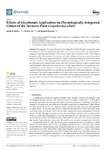Effects of Glyphosate Application on Physiologically Integrated Clones of the Invasive Plant Carpobrotus edulis

Use este enlace para citar
http://hdl.handle.net/2183/29459
A non ser que se indique outra cousa, a licenza do ítem descríbese como Atribución 4.0 Internacional
Coleccións
- Investigación (FCIE) [1259]
Metadatos
Mostrar o rexistro completo do ítemTítulo
Effects of Glyphosate Application on Physiologically Integrated Clones of the Invasive Plant Carpobrotus edulisData
2022-01-12Cita bibliográfica
Roiloa, S.R.; Yu, F.-H.; Barreiro, R. Effects of Glyphosate Application on Physiologically Integrated Clones of the Invasive Plant Carpobrotus edulis. Diversity 2022, 14, 47. https://doi.org/10.3390/d14010047
Resumo
[Abstract] Management of invasive alien species is a high priority for biodiversity conservation. Here, we studied the effects of glyphosate application, at 0.06 g/m2 concentration, on physiologically integrated basal and apical ramets of the invasive clonal plant Carpobrotus edulis. Physiological integration allows the transport of resources and other substances between connected ramets in clonal plants. We found a significant reduction of growth and photochemical efficiency both in basal and apical ramets of C. edulis after glyphosate application. Interestingly, we also observed a significant growth reduction in untreated basal ramets when they remained connected to apical ramets treated with glyphosate. This result was interpreted as a cost for basal ramets due to supporting severely stressed apical ramets. Therefore, local application of glyphosate to apical ramets of C. edulis can negatively affect not only their own growth, but also the growth of their interconnected, untreated basal ramets. Our results suggest that glyphosate effectiveness can be maintained when applied only to one part of the clone so that the amount of herbicide used in eradication programs can be greatly reduced, which can minimize the negative impact of chemical herbicides on ecosystems.
Palabras chave
Biological invasions
Biomass partitioning
Carpobrotus
Chemical control
Chlorophyll fluorescence
Clonal growth
Division of labour
Glyphosate
Photochemical activity
Physiological integration
Biomass partitioning
Carpobrotus
Chemical control
Chlorophyll fluorescence
Clonal growth
Division of labour
Glyphosate
Photochemical activity
Physiological integration
Versión do editor
Dereitos
Atribución 4.0 Internacional
ISSN
1424-2818






